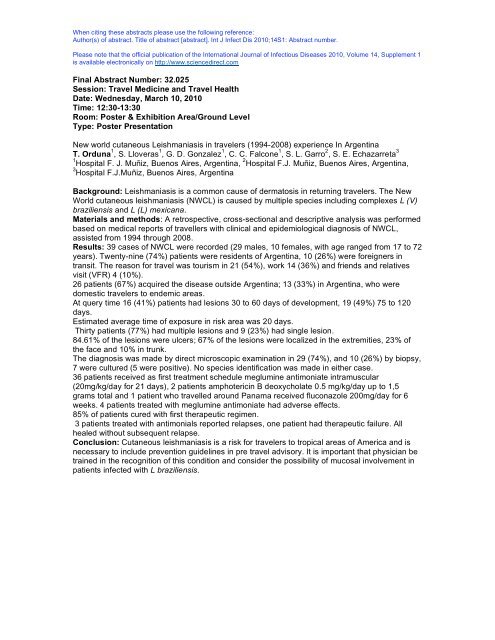14th ICID - Poster Abstracts - International Society for Infectious ...
14th ICID - Poster Abstracts - International Society for Infectious ...
14th ICID - Poster Abstracts - International Society for Infectious ...
Create successful ePaper yourself
Turn your PDF publications into a flip-book with our unique Google optimized e-Paper software.
When citing these abstracts please use the following reference:<br />
Author(s) of abstract. Title of abstract [abstract]. Int J Infect Dis 2010;14S1: Abstract number.<br />
Please note that the official publication of the <strong>International</strong> Journal of <strong>Infectious</strong> Diseases 2010, Volume 14, Supplement 1<br />
is available electronically on http://www.sciencedirect.com<br />
Final Abstract Number: 32.025<br />
Session: Travel Medicine and Travel Health<br />
Date: Wednesday, March 10, 2010<br />
Time: 12:30-13:30<br />
Room: <strong>Poster</strong> & Exhibition Area/Ground Level<br />
Type: <strong>Poster</strong> Presentation<br />
New world cutaneous Leishmaniasis in travelers (1994-2008) experience In Argentina<br />
T. Orduna 1 , S. Lloveras 1 , G. D. Gonzalez 1 , C. C. Falcone 1 , S. L. Garro 2 , S. E. Echazarreta 3<br />
1 Hospital F. J. Muñiz, Buenos Aires, Argentina, 2 Hospital F.J. Muñiz, Buenos Aires, Argentina,<br />
3 Hospital F.J.Muñiz, Buenos Aires, Argentina<br />
Background: Leishmaniasis is a common cause of dermatosis in returning travelers. The New<br />
World cutaneous leishmaniasis (NWCL) is caused by multiple species including complexes L (V)<br />
braziliensis and L (L) mexicana.<br />
Materials and methods: A retrospective, cross-sectional and descriptive analysis was per<strong>for</strong>med<br />
based on medical reports of travellers with clinical and epidemiological diagnosis of NWCL,<br />
assisted from 1994 through 2008.<br />
Results: 39 cases of NWCL were recorded (29 males, 10 females, with age ranged from 17 to 72<br />
years). Twenty-nine (74%) patients were residents of Argentina, 10 (26%) were <strong>for</strong>eigners in<br />
transit. The reason <strong>for</strong> travel was tourism in 21 (54%), work 14 (36%) and friends and relatives<br />
visit (VFR) 4 (10%).<br />
26 patients (67%) acquired the disease outside Argentina; 13 (33%) in Argentina, who were<br />
domestic travelers to endemic areas.<br />
At query time 16 (41%) patients had lesions 30 to 60 days of development, 19 (49%) 75 to 120<br />
days.<br />
Estimated average time of exposure in risk area was 20 days.<br />
Thirty patients (77%) had multiple lesions and 9 (23%) had single lesion.<br />
84.61% of the lesions were ulcers; 67% of the lesions were localized in the extremities, 23% of<br />
the face and 10% in trunk.<br />
The diagnosis was made by direct microscopic examination in 29 (74%), and 10 (26%) by biopsy,<br />
7 were cultured (5 were positive). No species identification was made in either case.<br />
36 patients received as first treatment schedule meglumine antimoniate intramuscular<br />
(20mg/kg/day <strong>for</strong> 21 days), 2 patients amphotericin B deoxycholate 0.5 mg/kg/day up to 1,5<br />
grams total and 1 patient who travelled around Panama received fluconazole 200mg/day <strong>for</strong> 6<br />
weeks. 4 patients treated with meglumine antimoniate had adverse effects.<br />
85% of patients cured with first therapeutic regimen.<br />
3 patients treated with antimonials reported relapses, one patient had therapeutic failure. All<br />
healed without subsequent relapse.<br />
Conclusion: Cutaneous leishmaniasis is a risk <strong>for</strong> travelers to tropical areas of America and is<br />
necessary to include prevention guidelines in pre travel advisory. It is important that physician be<br />
trained in the recognition of this condition and consider the possibility of mucosal involvement in<br />
patients infected with L braziliensis.
















